1 Chapter 1: Introduction to Digital Literacy
Cheryl Brown

Overview
In this chapter, you will be introduced to the concept of digital literacy and what new skills are needed in order to engage with the digital world responsibly and effectively. Drawing on your own digital experiences you will think about your digital literacy and digital footprint, developing positive strategies to proactively take control of your own digital identity.
Chapter Topics
- Introduction
- Taking Stock of Your Digital self
- What is Digital Literacy?
- Why is Digital Literacy Important?
- Improving Your Digital Literacy: Becoming a Digital Citizen
Learning Objectives
After completing this chapter you should be able to:
- Describe the ways you use technology in your personal life and for learning
- Compare the different ways digital literacy has been referred to by scholars
- Examine how digital literacy differs between people based on the context in which they live and learn and the way they use technology
- Use a basic framework to assess your own digital literacy
- Reflect on your digital footprint
- Develop strategies to control your own digital identity
Introduction
As digital technology has become more common, affordable, and portable, more and more people from all parts of society are starting to increase their online and digital participation. Understanding the new opportunities, rules, and potential pitfalls of the digital world doesn’t necessarily come automatically with long-term use. Not everyone using digital technology knows how to handle the range of available tools to their best extent, and even experienced digital technology users can fall prey to hackers, lose control of how they are represented online, or otherwise fail to maintain their digital identity in an optimal manner.
Digital literacy is a relatively new concept that emerged in the 1990s during the era of the Internet revolution. Before that, people talked more about “computer literacy.” But in 1997, Paul Gilster, a historian and educator first coined the term “digital literacy,” arguing that digital literacy went beyond just skills in using technology. He said it is about “mastering ideas, not [computer] keystrokes” (Gilster, 1997, p. 1).
Gilster (1997) further defined digital literacy as “the ability to understand and use information in multiple formats from a wide range of sources when it is presented via computers” (p. 1). For him, digital literacy involves the ability to critically evaluate information (presented in different formats) and make decisions about how to use this information in different real-life contexts.
By the end of this chapter you will be able to define the concept of digital literacy and its many different components, reflect on your own digital literacy, engage with the digital world responsibly, and be empowered as a digital citizen capable of helping others learn and develop their role in the digital world.
Taking Stock of Your Digital Self
You probably already use a range of technologies and digital tools in different aspects of your life. You might use mobile technologies, like a phone or tablet, to download materials or information from the Internet, or you may use them to communicate with friends and family. You may use information and communication technologies (ICT) mainly for work or for learning, or you might use it primarily for entertainment. In reality, people often use different technologies and tools for a mixture of purposes.
Activity 1.1: Thinking About Your Digital Self
Think about all the ways you use technology in your personal life (e.g. for entertainment, shopping, sharing photos, communicating with people, etc). Who do you interact with digitally, and how do you do this (i.e., what applications/websites do you use and for which purpose)? Now think about yourself as a student and the ways you use technology for learning?
Make a list or draw a diagram of your activities, noting the groups or networks you interact with digitally and thinking about how you use digital technology in the various spheres of your life.
You might like to try doing this digitally using this editable mind map about digital footprints on creatly.com or by making a drawing of your digital self on paper.
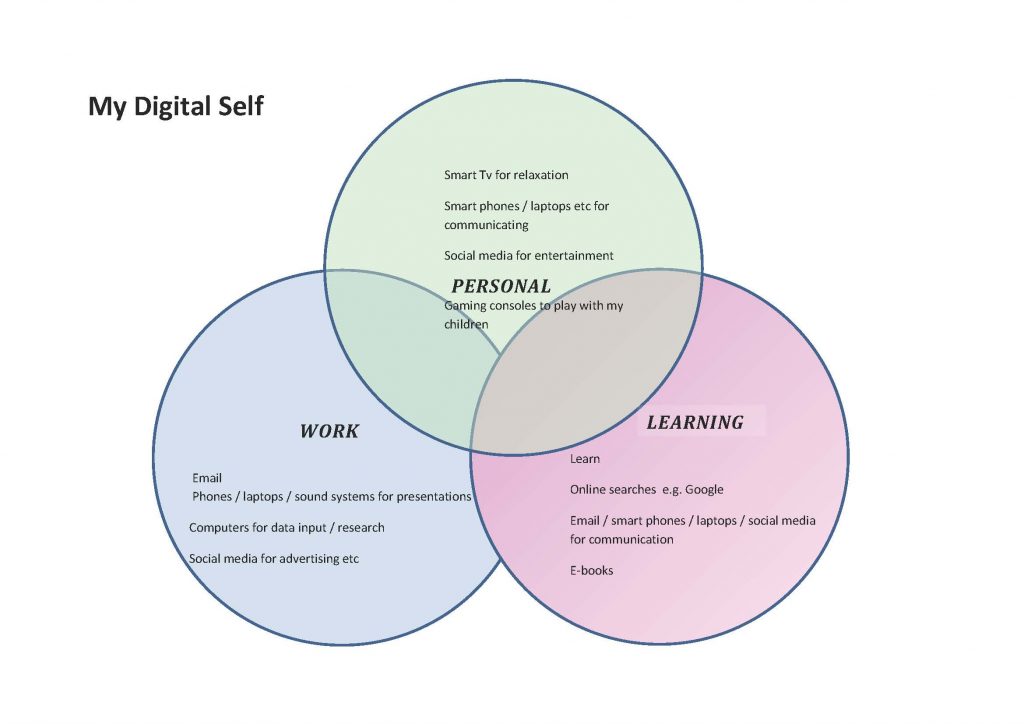
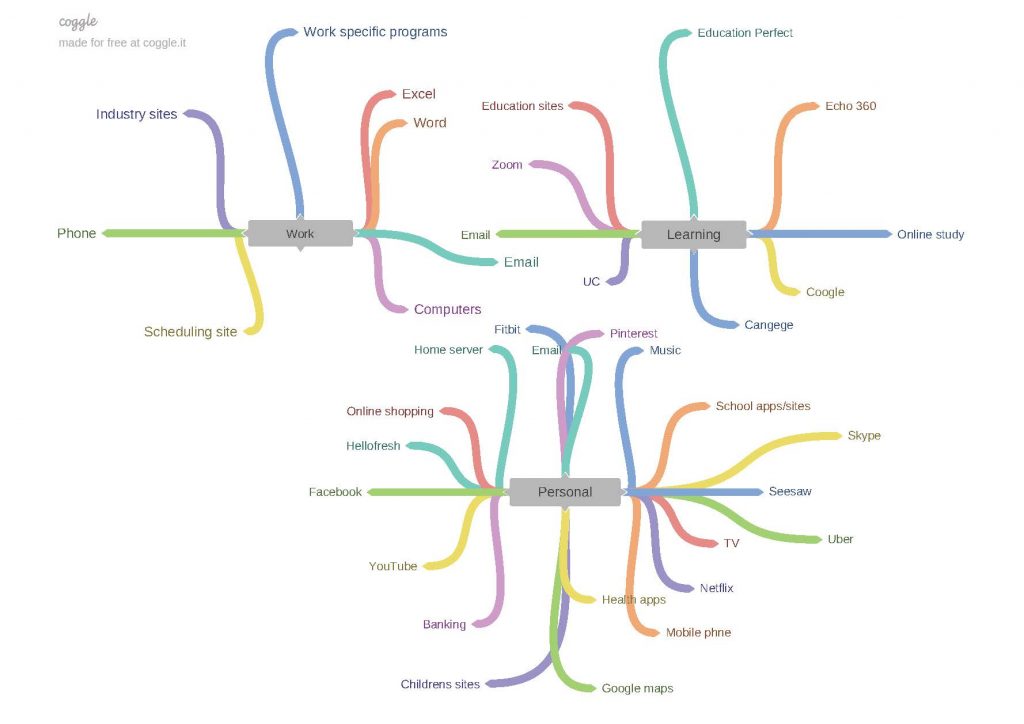
What is Digital Literacy?
The Concept of Literacy
Let’s first start with “What is literacy?” Dictionaries define literacy as the ability to read and write. Within education, literacy is understood as the ability to read, write, and use arithmetic; the emphasis is on proficiency with language and numeracy.
It is important to pause and note that the term literacy has always held a degree of status. Globally, countries are often ranked in terms of literacy rates, compared by what percent of the adult population can read and write, for example. There is more complexity to the terms literate or illiterate, however, and a lot depends on context. “New literacy studies” view literacy as a situated practice; as in it all depends on where you come from and what your purpose is.
Activity 1.2: How is literacy depicted on the Internet?
Use a common search engine like Google and type the term “literacy” into the search bar. Select the option to view the results as images and scroll through the visual depictions of literacy. What do these images depict about the concept of literacy?
Much of what you find in your search will probably suggest a relationship between literacy and words. This may be attributed to the fact that the concept has traditionally been associated with language—i.e., alphabetic literacy. In popular use, the word literacy has increasingly become a synonym for skill, competence, and proficiency—for example, emotional literacy and spiritual literacy, etc.
Whatever your view of the word literacy, what is less questioned is the relationship between literacy and technology. Until quite recently, literacy has, for the most part, been associated with print technology. The increasingly important role that digital technology has taken in shaping our world has led to another defining moment in the evolution of literacy.
The Concept of Digital
So what is digital? When you thought about your digital self in Activity 1.1, you probably thought about the digital tools and technologies that are available to you. For example: “Oh, I use text messaging on my cell phone to communicate with friends.” Or: “I use email at university on my laptop or in the computer lab to communicate with faculty.” But the digital part (just like literacy) depends on context. The technology that you use and may even take for granted is not the same technology that your grandparents use or that students in another country use. This is why the concept of digital literacy is more often now referred to as digital literacies as a plural, acknowledging the variability of what is both available and relevant.
Digital Literacy
Since the pioneering introduction of computers into education in the 1960s, four key concepts that have dominated the literature on literacies related to digital technology include: information literacy, media literacy, computer literacy, and digital literacy (Brown, Czerniewicz, Huang & Mayisela, 2016). These four literacies are not competing, but in fact are necessary components of what it means to be literate in the twenty-first century. The table below presents an outline of the different terms and how they intersect:
| Information Literacy | Media Literacy | Computer Literacy | Digital Literacy | |
| Definition | the ability to locate, identify, retrieve, process and use digital information optimally (UNESCO, 2011) | the ability to access the media, to understand and to critically evaluate different aspects of the media and media content, and to create communications in a variety of contexts (European Commission, 2007) | a set of user skills that enable active participation in a society where services and cultural offerings are computer supported and distributed on the Internet (UNESCO, 2011) | those capabilities which fit an individual for living, learning and working in a digital society (JISC, 2015) |
| Primary Focus | information retrieval and assessment of quality | evaluation and production of media texts | skills in the use of computer-related technology | innovation, collaboration, lifelong learning |
The concept of digital literacy only started to gain attention in the last decade. Initially digital literacy was viewed primarily as the functional skills and competencies that people needed in order to use computers and the Internet. However in the last decade this has been expanded to consider the broader capacity needed to participate in a digital environment. UNESCO (2011) views digital literacy as a life skill that not only increases employability, but serves as a catalyst that “enables the acquisition of other important life skills” (p. 1).
The view of digital literacy offered by Jisc (2015) is even more comprehensive, defining digital literacy as “the capabilities which fit someone for living, learning and working in a digital society” (para. 3). The capabilities outlined by Jisc:
- information, media, data literacy (critical use);
- digital creation, scholarship and innovation (creative production);
- digital communication, collaboration and participation (participating);
- digital learning and personal/professional development (learning); and
- digital identity and wellbeing (self-actualising).
(JISC, 2015)
Beyond functional and critical skills, the definitions and digital capabilities identified here propose a particular mindset, a way of being. In particular, the last three capabilities outlined—the abilities to engage in participatory culture, to be a lifelong learner, and to manage a professional digital identity—render digital literacy remarkably different from the initial views of digital literacy simply as mastery of technical skills.
Why is Digital Literacy Important?
You might be familiar with the concept of a “digital native” or the “net generation.” These terms refer to the idea that a person who has been born or brought up during the age of digital technology will be familiar with computers and the Internet from an early age.
Activity 1.3: Generational View of Digital Natives
There are many cartoons online that comment on the amusing side of this concept. Do a search on Google (or your favourite search engine) for “digital native” a cartoon. You might see images of kids looking at a book with shock and asking each other, “Where is the ‘on’ button?” Or you might see a child returning home from school walking right past their parent exclaiming, “How do you think it was? They didn’t even have Wi-Fi!”
In fact, this generational desire to be constantly connected has even been inserted into Maslow’s hierarchy of needs as the ultimate foundation of basic human needs. This psychological model is depicted as a pyramid with people’s basic survival needs as its foundation which need to be satisfied before people can realise their full potential (Figure 1.3).
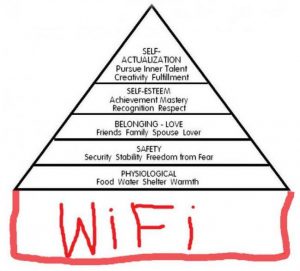
However, there has been a lot of criticism about the concept of the digital native because it assumes many things, not least that somehow all young people have access to technology, that older people don’t have the same level of digital literacy as younger people, and that having access to technology automatically means you know how to use it.
So if young people are so adept at using digital technologies, why do they (and perhaps you for that matter) need to improve their digital literacy?
There are many answers, and hopefully this introduction has already hinted at some of them. One is that it’s not enough in this globally connected world to just be able to use technology. You need to be able to develop socially responsible digital practices and also to contribute to digital practices in your own personal, work, and learning lives.
One way of visualizing this is Sharpe and Beetham’s (2010) digital literacy development model (see Figure 1.4).
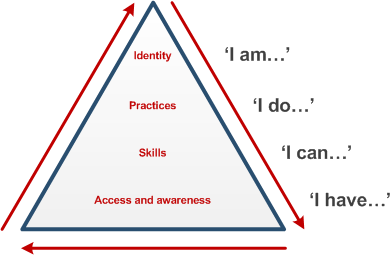
The pyramid represents a cyclical process for developing digital literacy skills. At the base of the pyramid is awareness of technology and access to it. However, just because you have a piece of hardware or software doesn’t mean you have the ability to use it effectively. As you spend more time using technology, you become more confident in your technical, information, communication, and learning skills. You can then begin to apply those skills to make informed decisions and choices about how to use different technologies. As you move through the cycle, your experiences and practices contribute to the formation of your digital identity, while your identity informs your practices and drives the creative and appropriate use of technology.
Improving Your Digital Literacy: Becoming a Digital Citizen
This book is aimed at helping you develop your digital literacy in a range of areas in order to become a digital citizen.
Activity 1.4: How digitally literate are you?
Why not take stock of where you are right now. How digitally literate are you, and do you know what that means?
Download this model of the digital literacy development framework and complete it while thinking about your access, skills, practices and identities. This will help you take stock of where you are now and help you focus on where you want to develop.
Explore Your Digital Identity
Digital identity refers to your “online self,” the side of you that people see on the Internet. We all have different identities in different contexts and one of the things about being a digital citizen is the ability to control the representation of yourself in the online environment.
Activity 1.5: How do others see you online?
Search for references to yourself on the Internet by looking up your name using your preferred search engine. What do you have to type in to find the “real you” and not either someone else with the same name or a one-dimensional representation of you? Is this an accurate representation of who you are, what your interests are, what you find interesting, and what you share with others online?
Once you’ve reviewed your search results, have a look at this TedX talk “What Do Your Digital Footprints Say About You?” by digital education and social media expert Nicola Osbourne.
Were you happy with the results of the search in Activity 1.5? Is there something you would like to change? One of the problems with information online is that once it is there, it is often very difficult to delete. Being aware of what you share online is a very important digital skill.
Using the image below (Figure 1.5), reflect on your digital footprint. Decide on some SMART goals (specific, measurable, attainable, relevant, and time-bound), and identify how you want the virtual “you” to look to the various people who might see you online: friends, family (including your grandmother!), teachers and professors, coaches, neighbours, potential employers, potential dates, or complete strangers.
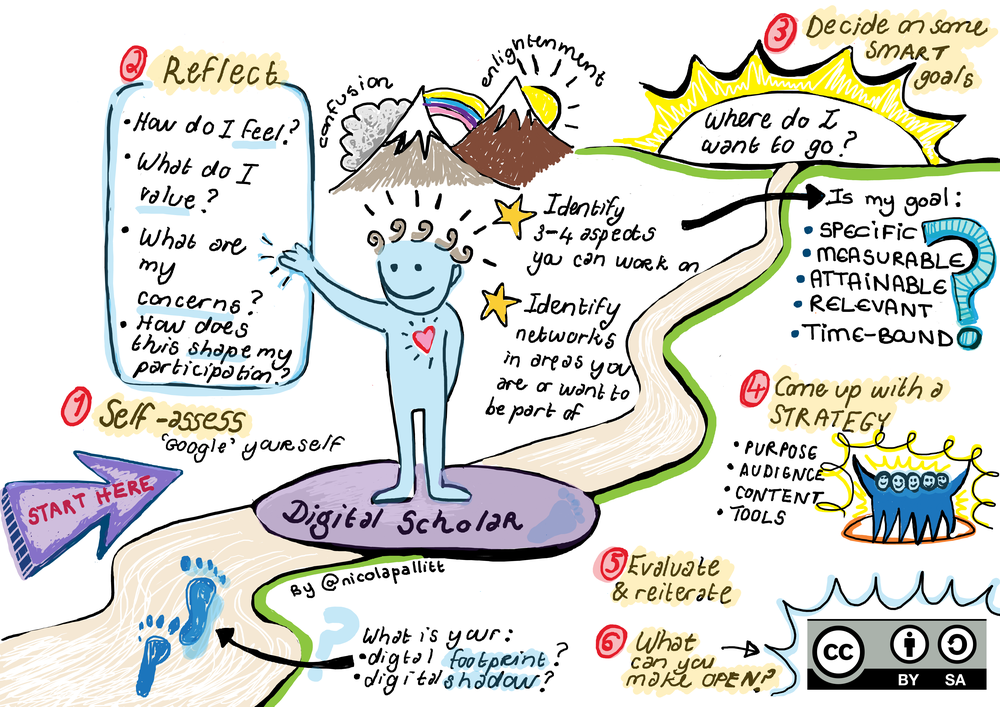
This book is aimed at helping you develop your digital literacy in a range of areas in order to become a better digital citizen. By the end of this book, you will be able to more effectively and responsibly:
- Engage in digital practices.
- Critically evaluate information, online interactions, and online tools.
- Manage and communicate information.
- Collaborate and share digital content.
References
Brown, C., Czerniewicz., L., Huang, C-W., & Mayisela., T. (2016). Curriculum for digital education leadership: A concept paper. Burnaby, BC: Commonwealth of Learning. Retrieved from http://oasis.col.org/handle/
European Commission (2007). A European approach to media literacy in the digital environment. Retrieved from http://eur-lex.europa.eu/LexUriServ/LexUriServ.do?uri=COM%3A2007%3A0833%3AFIN%3AEN%3APDF
Gilster, P. (1997). Digital Literacy. New York, NY: John Wiley & Sons, Inc.
JISC. (2015). Developing students’ digital literacy. Retrieved from https://www.jisc.ac.uk/guides/developing-students-digital-literacy
Sharpe, R. & Beetham, H. (2010) Understanding students’ uses of technology for learning: Towards creative appropriation. In R. Sharpe, H. Beetham and S. de Freitas (Eds.) Rethinking learning for a digital age: how learners shape their experiences, (pp. 85-99). Routledge Falmer, London and New York. Retrieved from https://radar.brookes.ac.uk/
UNESCO Institute for Information Technologies in Education. (2011, May). Digital literacy in education policy brief. Retrieved from http://unesdoc.unesco.org/images/0021/002144/214485e.pdf
The ability to understand and use information in multiple formats from a wide range of sources when it is presented via computers
The way you use the range of technologies and digital tools you use in different aspects of your life
Those capabilities which fit an individual for living, learning and working in a digital society
The idea that a person who has been born or brought up during the age of digital technology will be familiar with computers and the Internet from an early age.
Refers to your “online self”, the electronic representation of who you are.
The trail of ‘electronic breadcrumbs’ you leave behind you as you use the internet both intentionally but also unintentionally.
Goals that are Specific, Measurable, Attainable, Relevant, and Time-bound.

